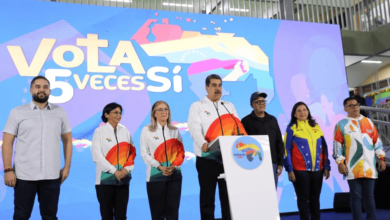On March 8, President George Bush left the United States on a six-day trip through Latin America. He traveled through Brazil, Uruguay, Colombia, Guatemala and Mexico.
The Bush administration has been criticized by sections of the ruling class for putting too much focus on the Middle
 |
The stated objectives of the trip—heavily sugar-coated for public consumption—were to promote “free trade, democracy and cooperation with the United States.”
But the people of Latin America didn’t buy the capitalist propaganda. Everywhere Bush traveled he faced mass resistance from workers and oppressed people.
In recent years, U.S. neoliberal trade policies have been met with substantial resistance for attempting to burst open Latin American markets while maintaining juicy government subsidies for American agricultural products. The continent’s electoral shift toward the left has failed to produce reliable U.S. puppets—an unquestionable indicator to the Bush administration that “democracy” must be lacking.
Protests greet Bush
The March 5 National “Bush Out” Graffiti Day mobilized Brazilians to spray paint messages against Bush in public places. The Brazilian media estimates some 10,000 protesters brought downtown São Paulo—the financial capital of the country—to a standstill on March 8. The National Security Force had been mobilized and responded with violence, but were unable to break the spirit of the demonstrators.
The demonstrations against Bush were incorporated into the celebrations of International Women’s Day, lending it an anti-imperialist character. About 50 social organizations, including the Landless Workers’ Movement (MST), the Workers’ United Central (CUT) and the National Student Union (UNE) joined the actions.
“Bush is not welcome,” said Antônio Carlos Spis from the CUT’s national leadership. “We will say ‘Bush out’ and protest his presence.”
UNE President Gustavo Petta also held a symbolic “Bush Hunt” when students burned effigies of Bush and threw red paint to represent the blood spilled in Iraq.
Demonstrators denounced the free trade model touted by the United States and pointed out that ethanol is far from being a solution to global warming.
The messages directly targeted some of Bush’s objectives for his meeting with President Lula—namely, to try to remove some obstacles posed by Brazil to during the Doha rounds of World Trade Organization talks and to jumpstart talks on U.S. purchase of ethanol for use in American vehicles.
The United States can milk some political benefits from the reputation of ethanol as a more environment-friendly fuel while evading a discussion of its role in undermining emissions control treaties and remaining the largest polluter in the world.
One key element of Bush’s trip was to attempt to undermine the influence of President Hugo Chávez, whose popularity among Latin American workers reaches well beyond the borders of his home country, Venezuela.
Bush explicitly criticized some of the revolutionary measures taken by Venezuela. “I strongly believe that government-run industry is inefficient and will lead to more poverty,” Bush declared. “The United States brings a message of open markets and open government to the region.”
Of course, the U.S. ruling class and its governmental representatives could care less about poverty in Latin America. The United States and its imperialist partners siphon enormous amounts of wealth from the region through neoliberal policies imposed by the U.S.-backed IMF and other institutions of finance capital. A modern mechanism of imperialist exploitation, neoliberalism is a primary factor in the region’s lingering poverty and underdevelopment.
The concerns of the U.S. ruling class regarding Chávez are not paranoia. Venezuela’s socialist project poses real obstacles to U.S. imperialism. Venezuela has taken significant steps towards reorienting its economy towards meeting people’s needs—something altogether incompatible with the insatiable thirst for profits of U.S. or transnational corporations. Fed up after decades of neoliberalism, capitalists are concerned that Latin American workers could learn dangerous lessons from the Venezuelan experience.
The Chávez tour
As Bush toured Latin America, Chávez went on his own tour of the continent. He led a march of many tens of thousands on March 9 at a stadium in Buenos Aires. The event was organized by the Mothers of the Plaza de Mayo—an organization of Argentinean mothers whose sons and daughters were “disappeared” by agents of the military dictatorship in the late 70s and early 60s.
Chávez’s visit to Argentina also had a diplomatic component. He participated in talks regarding cooperation between Petróleos de Venezuela S.A. (PDVSA) and Energía Argentina Sociedad Anónima (ENARSA), as well discussions about the Banco del Sur, scheduled to open officially this summer.
Such efforts by the Chávez government to build regional ties and mutual cooperation in Latin America put the entire region in a stronger position vis-à-vis U.S. imperialism.
As the people of Latin America showed during Bush’s trip, the U.S. empire is setting itself up for real a fight in its “own backyard.”






